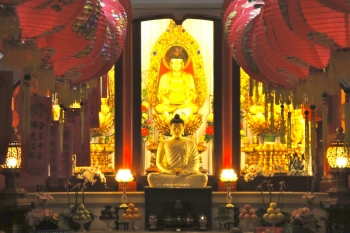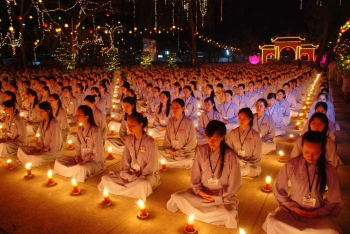This sacred truth was attested to in a corpus of Pure Land texts that matured and rose to prominence during China's Sui and Tang periods: Vasubandhu's Treatise on Rebirth in the Pure Land, Tanluan's Commentary on the Treatise on Rebirth in the Pure Land, Daochuo's Collection on the Land of Peace and Joy and Shandao's Five Works in Nine Fascicles. But this tradition of “Sui-Tang” Pure Land was not to last on the Chinese mainland after Emperor Wuzong’s persecutions in the late Tang Dynasty. What replaced them was a now more familiar brand, or image, of Pure Land: a “Song-Ming” syncretism that, in its day, seemed reasonable and necessary after the decline of Tiantai, Huayan, and other irreplaceable schools. But the amalgamation of major traditions like Pure Land, Ch’an, Tiantai, and Huayan has, for modern Pure Land Buddhists, somewhat complicated the practice of the Song-Ming tradition whilst diluting the pure, simple message of Shandao's original lineage.
The teachings of the Sui-Tang stream survived only in Japan until the dying years of the Qing Dynasty, when Yang Renshan brought the original texts back to China. To many Chinese Buddhists, Shinran's theology of Amida Buddha in the Jodo Shinshu school resembles the simple, devotional Sui-Tang lineage of Shandao. However, there is a significant divergence of thought between the Shinran and Sui-Tang traditions that is too often overlooked. In fact, part of Pure Land’s mystique and impenetrability is often due to confusion about what exactly Pure Land Buddhism stands for, and which critical nuances of thought distinguish its living practice. Many understand that the chanting of Amitabha's Name is of paramount importance, but little else is known about Pure Land principles, the inspiring and profound rationale behind nianfo, and the influence of the Pure Land tradition on Chinese culture and art. As a result, there is an unfortunate gap between our intellectual understanding of nianfo and our appreciation for the sheer beauty and power of Pure Land doctrines. Clearly, there is a need for authoritative clarification and wider dissemination of Pure Land voices.
The teachings of the Sui-Tang stream survived only in Japan until the dying years of the Qing Dynasty, when Yang Renshan brought the original texts back to China. To many Chinese Buddhists, Shinran's theology of Amida Buddha in the Jodo Shinshu school resembles the simple, devotional Sui-Tang lineage of Shandao. However, there is a significant divergence of thought between the Shinran and Sui-Tang traditions that is too often overlooked. In fact, part of Pure Land’s mystique and impenetrability is often due to confusion about what exactly Pure Land Buddhism stands for, and which critical nuances of thought distinguish its living practice. Many understand that the chanting of Amitabha's Name is of paramount importance, but little else is known about Pure Land principles, the inspiring and profound rationale behind nianfo, and the influence of the Pure Land tradition on Chinese culture and art. As a result, there is an unfortunate gap between our intellectual understanding of nianfo and our appreciation for the sheer beauty and power of Pure Land doctrines. Clearly, there is a need for authoritative clarification and wider dissemination of Pure Land voices.
A new website called PureLandBuddhism.org aims to introduce the teachings of Shandao (the Sui-Tang tradition) to a wider audience beyond East Asia. In this website, the doctrines in the Pure Land sutras as well as the works of Vasubandhu, Tanluan, Daochuo, and Shandao are given appropriate coverage and exegesis. It covers a host of major sections, from “Teachings and Practice” to “Publications” and accounts of the meritorious and beneficial application of Pure Land teachings. It is a treasury of resources for everyone who wishes to understand more of Amitabha’s vows and invitation to his Pure Land. We are confident that this new website, along with the hard work of many others, will help clarify some of the many questions surrounding the most urgent and critical issue of all: the afterlife and ultimate destiny of all beings.
















